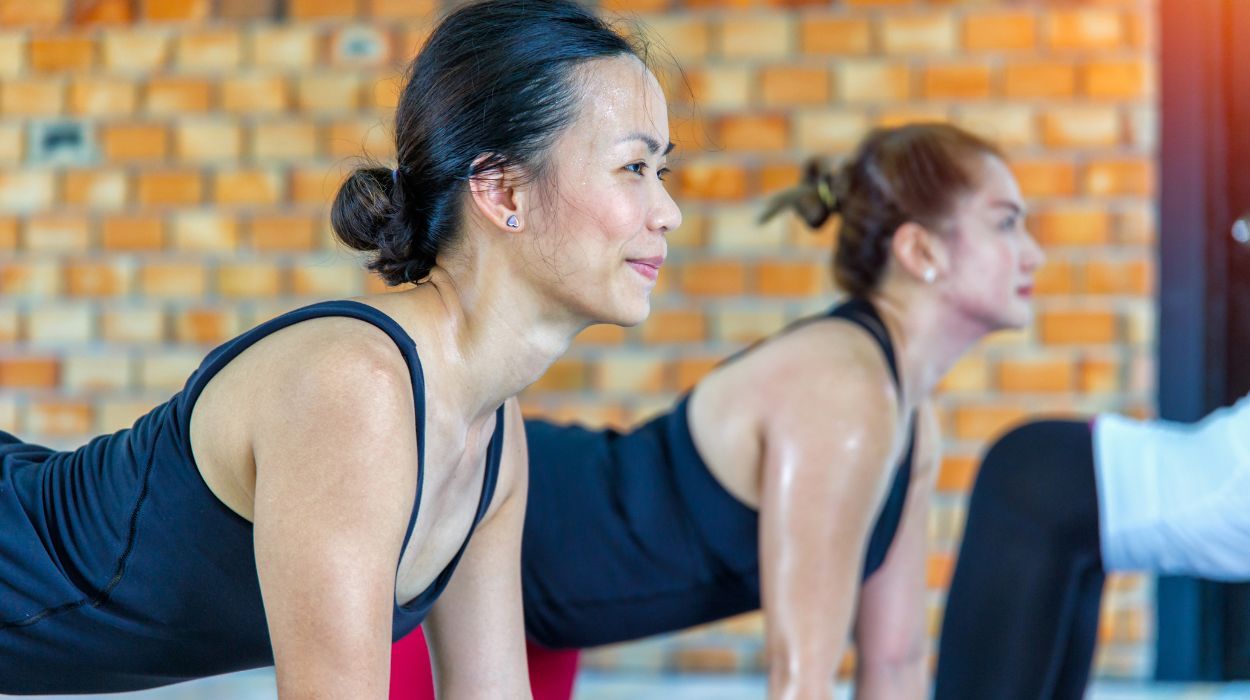Improved health and physical appearance are common aspirations many people have. We all want to be healthy and function at our best.
A healthy lifestyle has many benefits, with improved quality of life at the top. If you want to know how to get ripped in 30 days, you’ll find this article realistic and effective. Remember, results will vary based on your starting body weight, exercise routine, and dietary intake. With that being said, let’s get to it.
How To Get Ripped In 30 Days
Workouts to get shredded in 30 days:
- Strength training.
- High-intensity interval training.
- Cardio.
- Boxing.
- Hot Yoga.
In addition to working out, other factors to help you gain muscle and lose fat include maintaining a calorie deficit, eating a healthy diet, and getting enough sleep.
Workouts To Get Ripped In A Month
Thankfully, you can do many different exercises to get fit and healthy in a relatively short period. Whether you prefer the local gym or working out at home, we’ve got you covered. Here are five different workouts for a more toned and lean body.
Strength Training
Getting ripped often requires you to build muscle, and one of the most popular ways to do that is through strength training. This is commonly referred to as weight lifting and can be done at your local gym or in the comfort of your home with the right equipment.
Lifting weights helps increase lean body mass and boost your metabolism.[1] Why is an increased metabolism helpful? It helps you burn more fat, which can help you become more lean and toned.
Studies vary widely, and little to no research shows it’s possible to get shredded in just 30 days. Experts recommend incorporating strength training at least twice a week[2] to maximize muscle growth results. But this doesn’t account for the time it will take to see results.
Cardio

Cardio exercise is one of the best ways to burn calories. There are also many different ways to get in your daily cardio, making it easy to incorporate in your life. The recommended amount of cardio for adults is a minimum of 150 minutes[3] of moderate-intensity aerobic exercise weekly.
If this sounds like a lot, don’t worry. Broken down, this is about 30 minutes daily, five times a week. Walking, jogging, cycling, and using the elliptical at the gym are just a few examples of cardio exercises you can choose from.
You may wonder what moderate-intensity exercise means, though. This refers to the intensity of the exercise[3] and how much it increases your heart rate. For example, walking would be considered a lighter-intensity exercise than running or jogging.
One study found combining cardio with resistance training to be a very effective way to lose body fat.[4] A decrease in body fat can help give the appearance of a more toned and lean body. It’s important to note this study does not account for quick results, such as 30 days.
High-Intensity Interval Training
One of the main obstacles to achieving a toned and fit body is time. Many gym programs involve working out four or five times a week for an hour or more. This is why high-intensity interval training has become so popular.
What is high-intensity interval training,[5] commonly referred to as HIIT? It involves short periods of high-intensity exercise with alternating periods of low-intensity exercise. These workouts allow you to burn around the same calories as other traditional exercises but within a much shorter time (up to 40%).
HIIT has shown to be just as effective for weight loss[5] and muscle toning as other forms of cardio exercise. This is perfect for anyone who may not have hours to spend at the gym. Even better, you can do this in the comfort of your home.
Boxing
To spice up your exercise routine, try boxing classes. Not for the faint of heart, these classes get your heart rate pumping, and the trainers push you to do your best. You’ll leave class in a puddle of sweat.
Boxing is considered a type of HIIT workout, but we think it deserves a category of its own. Participants in a study participated in boxing class[6] four times weekly over a 12-week period. This resulted in significant weight loss across the board.
While this doesn’t guarantee results in 30 days, it does prove to be an effective way to lose fat.
Hot Yoga

Engaging in hot yoga is thought to benefit weight loss and muscle toning. One study found weight and body fat percentages decreased significantly after participants attended hot yoga[7] classes for a year. This shows you may get even better results if done consistently over a longer period.
How Long Does It Usually Take To Get Ripped?
The honest answer is it depends. Everybody is different, and there are multiple factors to consider. Building muscle takes patience and consistency.
Generally speaking, you should start to see noticeable changes around eight weeks.[8] But it may take up to 12 weeks to begin to notice, depending on your exercise routine and diet. This means it would take about 2-3 months of consistent activity to begin to see changes in your body.
Is It Possible To Get Ripped In 1 Month?
It’s important to set realistic goals when it comes to your health. Based on the limited evidence, one month may be a bit of a crazy target to get ripped, especially if you are starting from scratch. Building muscle mass takes time and consistency.
Here are a few things to consider:
Calorie Deficit
You need to be in a calorie deficit to lose weight. This means you need to expend more energy or calories than you consume daily. A deficit of 750-1,000 calories[9] is recommended to lose 1-2 pounds weekly.
You can achieve a deficit through calorie restriction, exercise, or a combination of both. While you may want to lose weight faster, studies show gradual weight loss leads to greater fat loss and decreases in body fat percentage.[10]
Diet
An important part of reaching your physique goals, such as a ripped body, is a balanced diet. This means limiting processed foods containing additives and preservatives and little nutritional value.
Many processed foods can contain a lot of extra calories, which can contribute to weight gain. Common examples included packaged cookies, fried foods, and many frozen meals. While these may be easier to eat, it doesn’t mean they are healthier.
A balanced diet that focuses on getting enough healthy fats, carbs, and protein can contribute to a healthier lifestyle and physique. For example, one study found a Mediterranean diet effective for long-term weight loss.[9] This diet focuses on consuming fresh fruits and vegetables, healthy fats like nuts and olive oil, and lean meats like fish and chicken.
While there is limited research about specific diets related to shredding, there’s no doubt focusing on healthy foods can help you reach your goals. There is some evidence that shows consuming extra protein can help your muscles. Consuming 20-30 grams of protein[11] directly after engaging in strength training combined with daily dietary protein intake has been shown to affect muscle support positively.
Daily intake based on recommendations is around 1.6 grams per kilogram body weight, not including post-exercise protein consumption. The easiest way to get 20-30 grams of protein at once is through protein powder, which can be easily mixed with water or milk.
While there are many supplements on the market, it’s important to always talk with your healthcare provider before trying anything. Many diet pills claim to boost your metabolism, and the results vary widely between brands.
Sleep
While often overlooked, getting enough rest at night is crucial for your health. People who consistently sleep less than 7 hours[12] tend to be more overweight than those who sleep more.
Inadequate rest leaves you feeling groggy and may lead to decreased motivation to perform exercise. By making this a priority, you may feel more energized to stick to your exercise and diet plan.
Tips To Get The Most Of Your 1 Month Plan
One month may seem like a long time but it goes by faster than you think. To help you stay motivated, we recommend creating a 1-month workout plan that you can easily follow. This can take the stress away of having to set time aside daily to plan your workout.
It may also help to make a meal plan where you prep your food before the start of the week. This can help you stick to healthy eating habits and prevent you from consuming excess calories. It might also limit the temptation to buy fast food since you already have food made at home.
Conclusion
Since there is limited research on the efficacy of getting ripped in 30 days, we recommend focusing on your total body health. Long-term results don’t happen overnight. Rather than aiming for quick results, aim to lose 1-2 pounds per week by incorporating a daily deficit[9] of at least 750 calories.
Gaining muscle and becoming toned isn’t simply a matter of working out. It’s also important to consider the food you eat. Limit processed foods and make sure to eat fresh fruits and vegetables, healthy fats, and lean meats. A balanced diet[9] has been shown to support weight loss efforts and help you maintain weight loss.
Cardio, high-intensity interval training, strength training, boxing, and hot yoga are all exercises you can choose from to improve your fitness level. While there is limited evidence of how to get shredded in 30 days, these workouts all have associated weight-loss benefits. Creating realistic goals makes you more likely to get ripped and reach your goals!
Frequently Asked Questions
Achieving a ripped body takes time and consistency. Other factors like diet, starting weight, exercise routine, and lifestyle are important aspects to consider.
There is very little evidence to support this claim. Research shows it generally takes around eight weeks[8] before you can see results.
The methods to getting ripped are simple. We recommend a consistent workout routine and a balanced diet that challenges the energetic needs of your body. Giving it time, your body will grow muscles to adjust to the new lifestyle.
A healthy diet is important for reaching your fitness goals. While exercising, your body needs ample healthy nutrients to recover, which comes from a good diet. Dieting doesn’t only mean cutting calories, but also choosing healthier sources of calories.
 Evidence Based
Evidence Based